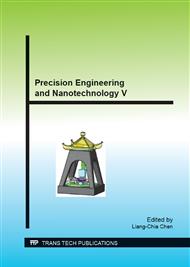p.207
p.213
p.219
p.224
p.230
p.234
p.241
p.247
p.253
Preliminary Investigation on Design and Fabrication of a Metallic-Ellipsoidal Neutron Focusing Mirror
Abstract:
Neutron beam is a very useful probe for material characterization and non-destructive testing. There are a number of plans to construct neutron instrumens using focusing mirror to improve beam quality with higher intensity and smaller spot size. In this paper, an ellipsoidal mirror made by a metal substrate is proposed. As the metal substrate, electroless nickel is adopted because of its amorphous structure, machinability and relatively large critical angle of neutron reflection. The design of ellipsoidal neutron focusing mirror is made by considering the neutron reflectivity. A mirror is fabricated by ultrahigh precision cutting and 1st polishing process, and the form accuracy of 5 μm P-V with surface roughness of 0.7 nm Ra is obtained. Through this experimental fabrication, the feasibility of the proposed method is verified.
Info:
Periodical:
Pages:
230-233
Citation:
Online since:
August 2014
Keywords:
Price:
Сopyright:
© 2015 Trans Tech Publications Ltd. All Rights Reserved
Share:
Citation:


